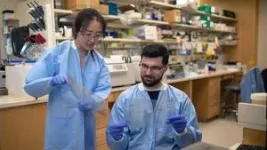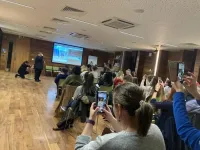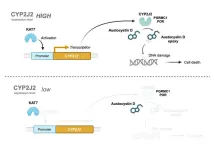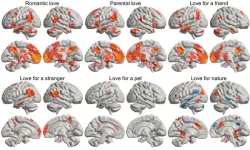(Press-News.org) The fight against cancer is an arms race, and one of the most effective weapons in clinicians’ arsenals is immunotherapy. Immune checkpoint therapy has become the standard for treating several types of cancer. However, the Nobel Prize-winning strategy is ineffective for most pancreatic ductal adenocarcinoma (PDAC) patients.
“Immune checkpoint therapy is only an option in rare cases of PDAC,” Cold Spring Harbor Laboratory (CSHL) Professor Douglas Fearon says. “It’s only effective for patients with a specific subtype of PDAC—that’s less than 5% of all cases.”
Until recently, it was thought that PDAC didn’t trigger any kind of immune response. In 2023, Fearon and his team confirmed the opposite. Immune cells do go on the attack. But they struggle to infiltrate the deadly tumors, which allows PDAC to avoid destruction. Now, Fearon and former CSHL postdoc Jiayun Li have discovered that a common chemotherapy supplement called folinic acid weakens the cancer’s defenses in mice. They found that folinic acid elevates levels of two anti-cancer immune molecules within PDAC: natural killer T (NKT) cells and type-I interferons. In mice, this leads to a more effective immune response, slower tumor growth, and longer survival.
“We discovered that NKT cells enabled type-I interferon to be produced and, as a consequence, adaptive immune killing and expansion of T cells would occur," says Fearon. "T cells respond to tumors, but they typically cannot get in there unless type-I interferon is produced. Folinic acid enhances that response.”
PDAC resists immune cells, using a protective shield built from two proteins—CXCR4 and CXCL12. This defensive wall is virtually impenetrable. But when the team treated PDAC tumors with folinic acid, cracks were revealed. The resulting elevated levels of NKT cells and type-I interferons acted like trail markers, highlighting a way past PDAC’s defenses. Cancer-killing immune cells that had been kept outside the wall were able to slip into the tumor and start fighting back.
The Fearon lab now aims to translate its discovery into new therapeutics. They’ve recently partnered with biotech company Autobahn Labs to develop potential drugs targeting CXCR4 and CXCL12. These may one day make immune checkpoint therapy a regular option in the fight against PDAC.
“Translating observations in mice into human therapy has been difficult,” Fearon says. “But if we’re successful, immunotherapy may one day become a viable choice for all patients with PDAC—and every other solid tumor—not just in the rare cases we see today.”
END
Old chemo drug, new pancreatic cancer therapy?
2024-08-26
ELSE PRESS RELEASES FROM THIS DATE:
Shakespeare in sign language, seen through AI
2024-08-26
A new study uses co-creation with reference communities to develop an app for sign language machine translation (SLMT). The research team designed a theatrical performance in sign language, seen through the eyes of artificial intelligence (AI), as one of the methodologies. “Historically, deaf people have been excluded from the development of automatic translation technologies,” says Shaun O’Boyle, Research Fellow in the School of Inclusive and Special Education (Dublin City University DCU). “This has often caused backlash and resistance from deaf communities, as the projects were designed and ...
PLOS and the University of South Carolina announce APC-free Open Access publishing agreement
2024-08-26
SAN FRANCISCO — The University of South Carolina and the Public Library of Science (PLOS) today announced a three-year Open Access agreement that allows researchers to publish in PLOS journals[1] without incurring article processing charges (APC). This partnership brings together two organizations that believe researchers should be able to access content freely and make their work available publicly, regardless of their access to funds.
“The evidence is undeniable — open research enables the convergence of ...
Why children can’t pay attention to the task at hand
2024-08-26
COLUMBUS, Ohio – Scientists have learned that children find it hard to focus on a task, and often take in information that won’t help them complete their assignment. But the question is, why?
In a new study, researchers found that this “distributed attention” wasn’t because children’s brains weren’t mature enough to understand the task or pay attention, and it wasn’t because they were easily distracted and lacked the control to focus.
It now appears that kids distribute their attention broadly either out of simple curiosity or because their working memory isn’t developed enough to complete a task without “over ...
Short-duration, light-intensity exercises improve cerebral blood flow in children
2024-08-26
Cognitive functions, also known as intellectual functions, encompass thinking, understanding, memory, language, computation, and judgment, and are performed in the cerebrum. The prefrontal cortex (PFC), located in the frontal lobe of the cerebral cortex, handles these functions. Studies have shown that exercise improves cognitive function through mechanisms such as enhanced cerebral blood flow, structural changes in the brain, and promotion of neurogenesis. However, 81% of children globally do not engage in enough physical activity, leading to high levels of sedentary behavior and insufficient exercise. This lack of physical ...
Exploring the role of cytochrome oxygenases in augmenting austocystin D-mediated cytotoxicity
2024-08-26
Austocystin D, a natural compound produced by fungi, has been recognized for its cytotoxic effects and anticancer activity in various cell types. It exhibits potent activity even in cells that express proteins associated with multidrug resistance, attracting significant global research interest. Austocystin D promotes cell death by damaging their DNA, a process which might be dependent on cytochrome P450 (CYP) oxygenase enzymes. Notably, austocystin D has shown significant activity against cancer cells with increased CYP expression. However, the specific role and function of the CYP2J2 enzyme in the cytotoxicity of austocystin D remain ...
Knowing you have a brain aneurysm may raise anxiety risk, other mental health conditions
2024-08-26
Research Highlights:
People diagnosed with unruptured cerebral aneurysms (weakened areas in brain blood vessels) who are being monitored without treatment have a higher risk of developing mental illness compared to those who have not been diagnosed with a cerebral aneurysm. The largest impact was among adults younger than age 40.
The study conducted in South Korea found that the psychological burden caused by the diagnosis of an unruptured aneurysm may contribute to the development of mental health conditions, such as anxiety, stress, depression, eating ...
Non-cognitive skills: the hidden key to academic success
2024-08-26
A new Nature Human Behaviour study, jointly led by Dr Margherita Malanchini at Queen Mary University of London and Dr Andrea Allegrini at University College London, has revealed that non-cognitive skills, such as motivation and self-regulation, are as important as intelligence in determining academic success. These skills become increasingly influential throughout a child's education, with genetic factors playing a significant role. The research, conducted in collaboration with an international team of experts, suggests that fostering non-cognitive skills alongside cognitive abilities could significantly improve educational ...
Finding love: Study reveals where love lives in the brain
2024-08-26
We use the word ‘love’ in a bewildering range of contexts — from sexual adoration to parental love or the love of nature. Now, more comprehensive imaging of the brain may shed light on why we use the same word for such a diverse collection of human experiences.
‘You see your newborn child for the first time. The baby is soft, healthy and hearty — your life’s greatest wonder. You feel love for the little one.’
The above statement was one of many simple scenarios presented to fifty-five parents, self-described as being in a loving relationship. Researchers from Aalto University utilised ...
Researchers develop high-entropy non-covalent cyclic peptide glass
2024-08-26
Researchers from the Institute of Process Engineering (IPE) of the Chinese Academy of Sciences have developed a sustainable, biodegradable, biorecyclable material: high-entropy non-covalent cyclic peptide (HECP) glass. This innovative glass features enhanced crystallization-resistance, improved mechanical properties, and increased enzyme tolerance, laying the foundation for its application in pharmaceutical formulations and smart functional materials. This study was published in Nature Nanotechnology on ...
Mapping the sex life of Malaria parasites at single cell resolution, reveals the genetics underlying Malaria transmission
2024-08-26
Malaria is caused by a eukaryotic microbe of the Plasmodium genus, and is responsible for more deaths than all other parasitic diseases combined. In order to transmit from the human host to the mosquito vector, the parasite has to differentiate to its sexual stage, referred to as the gametocyte stage. Unlike primary sex determination in mammals, which occurs at the chromosome level, it is not known what causes this unicellular parasite to form males and females. New research at Stockholm University has implemented high-resolution genomic tools to map the global repertoire of genes ...






